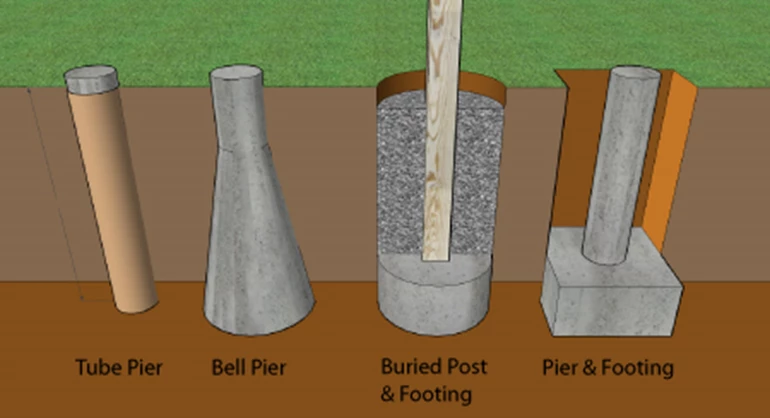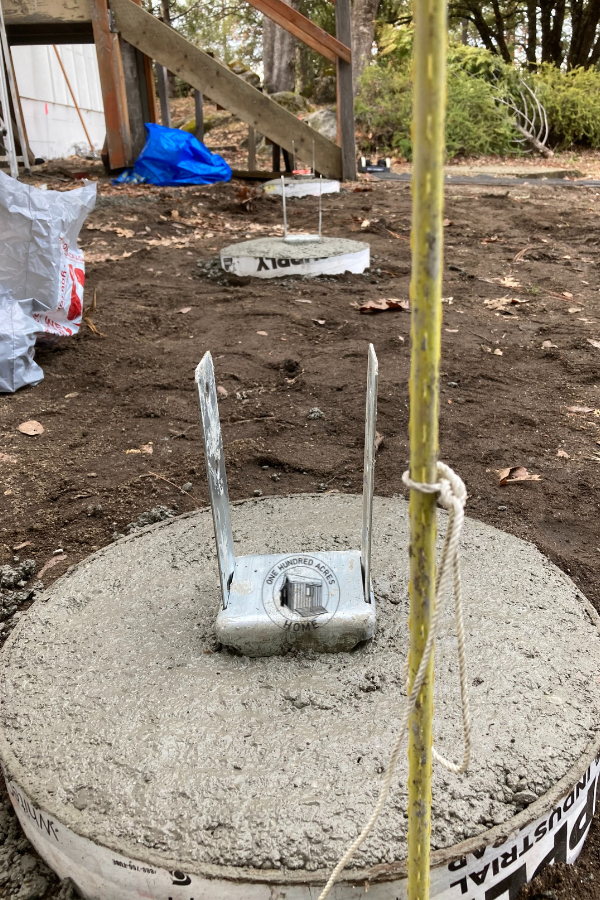Protect Structures, Long-term Impacts: Understanding the Art of Deck Footings Installation
Wiki Article
Professional Tips for Installing Deck Footings to Support Your Outdoor Room
When it comes to developing a deck, one of the most essential components to think about is the setup of appropriate grounds. These grounds are the structure upon which your outdoor area will certainly relax, giving stability and assistance for years to come. What exactly does it take to mount deck footings appropriately?Importance of Correct Deck Footings
Proper deck footings are necessary for ensuring the stability and durability of your outside area. When constructing a deck, it is vital to take note of the structure on which it will relax. Deck footings offer the essential support for the entire structure and assistance disperse the weight equally - Deck Footings. Without solid and correctly set up grounds, your deck may come to be unstable, bring about security dangers and costly repair services.
In addition to stability, appropriate deck grounds also add to the durability of your outside area (Deck Footings). Footings that are designed and built to endure the elements and dirt conditions in your location will certainly assist prevent the deck from changing or resolving gradually. By ensuring the grounds are properly sized and set up, you can minimize the risk of damages to the deck structure, expanding its life expectancy and minimizing the requirement for costly fixings or replacements

Choosing the Right Sort Of Footings
When picking the appropriate kind of footings for your deck, it is necessary to take into consideration elements such as soil conditions, neighborhood building regulations, and the overall style of your outdoor area. The kind of footing you select will play a crucial duty in making certain the security and longevity of your deck.One typical sort of ground is the concrete footing. Concrete footings are appropriate for the majority of dirt problems and supply exceptional assistance for decks. They are generally set up below the frost line to avoid changing and working out as a result of freezing and thawing cycles. An additional option is helical piers, which are excellent for locations with unsteady soil or high water tables. These piers are screwed right into the ground and supply strong support for the deck.
In many cases, you may require to use specialized grounds, such as pile grounds or deep structures, if you are building a big or multi-level deck. These footings are designed to disperse the weight of the deck over a bigger location, making certain stability and preventing settling or sinking.
Prior to choosing a kind of ground, it is necessary to seek advice from local building ordinance and laws to guarantee compliance. Furthermore, consider the style and meant use of your exterior space. Factors such as the dimension, form, and load-bearing needs of your deck will affect the kind of footing that is most ideal.
Preparing the Ground for Footing Setup
To effectively prepare the ground for footing installment, it is crucial to evaluate the dirt problems and take needed steps to make sure stability and longevity of the deck. The first action is to dig deep into the location where the footings will be installed.As soon as the area has been excavated, the next step is to small the soil. This can be done utilizing a plate compactor or by utilizing a hand meddle. Compacting the dirt aids to eliminate any type of voids or air pockets, which can result in resolving and instability with time.
After compacting the soil, it is necessary to lay a layer of gravel or smashed stone at the end of the excavation. This will certainly supply drain and aid to stop water from merging around the grounds, which can lead to disintegration and instability.
Step-by-Step Guide to Setting Up Deck Footings
After appropriately preparing the ground for footing installment, the next action is to start the process of setting up deck footings. This detailed guide will certainly offer you with a clear understanding of just how to set up deck footings for your outside space.Identify more the place: Begin by noting the settings of the deck grounds utilizing stakes and string. Make certain that the places align with the layout and format of your deck.
Dig the openings: Make use of an article hole digger or an auger to dig the holes for the grounds. The depth and diameter of the holes should be in conformity with local building ordinance and the particular requirements of your deck design.
Level the holes: Use a index degree to ensure that the holes are dug to the proper depth and are level with each other. (Deck Footings)
Add crushed rock: Place a layer of gravel at the end of each hole to boost drainage and protect against the timber from deteriorating.
Insert the grounds: Position the grounds right into the holes, making certain they are degree and plumb. Utilize a degree and a determining tape to make sure precision.
Safeguard the grounds: Pour concrete right into the holes around the footings, loading them to the top. Use a blog post level to guarantee the grounds continue to be level as the concrete collections.
Allow time for healing: Allow the concrete treatment according to the manufacturer's instructions before waging the deck building.
Usual Blunders to Stay Clear Of Throughout Footing Installment
One essential element to take into consideration during the setup of deck grounds is preventing typical blunders that can jeopardize the security and long life of your outdoor room. While deck grounds may look like a simple and straightforward component of the construction process, neglecting certain variables can result in expensive repair services and potential safety and security risks down the line.
Additionally, disregarding to mount appropriate drain actions can cause water to build up around the grounds, leading to rot, decay, and the eventual weakening of the deck's foundation. Furthermore, utilizing the wrong kind of footing product or failing to properly secure the footings can jeopardize their architectural integrity.
To prevent these blunders, it is vital to seek advice from a specialist or follow industry guidelines to make sure correct ground installation. By doing so, you can guarantee the stability and durability of your outside room, supplying a pleasurable and safe environment for Extra resources several years to find.
Verdict
To conclude, setting up correct deck footings is crucial for the security and durability of your exterior room. By selecting the best type of footings and effectively preparing the ground, you can make certain a strong foundation for your deck. Following a detailed guide and staying clear of common blunders during footing installment will even more improve the longevity and safety and security of your deck.Correct deck grounds are necessary for making certain the security and long life of your outside area. The footings offer as a link in between the ground and the deck, enabling the weight of the deck and its residents to be dispersed evenly right into the dirt.One usual kind of ground is the concrete footing. Insert the grounds: Position the grounds right into the openings, making sure they are level and plumb. Safeguard the footings: Put concrete right into the holes around the footings, loading them to the top.
Report this wiki page